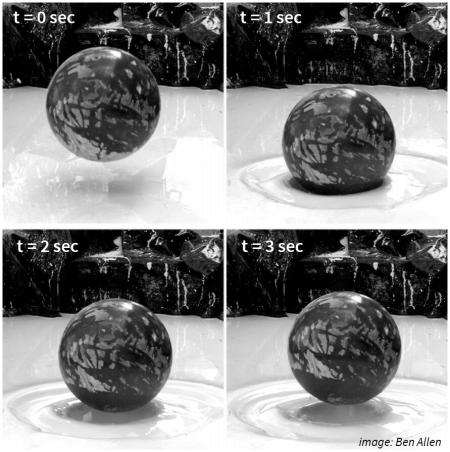Understanding the Amazing Properties of Cornstarch and Water

At the right ratio, a blend of water and cornstarch displays some mysterious qualities. It’s a liquid until you throw a bowling ball on it. Then it solidifies at the point of impact and the ball bounces off. You can find scores of online videos posted by people running on the substance, only to sink into after stopping.
 The substance – also known as “oobleck” in tribute to a Dr. Seuss story – makes for great party tricks, but researchers believe it could have a lot more practical applications, such as using it to make protective gear. The phenomenon happens when liquid is mixed with other substances made of small particles (about 10 microns each). Corn starch is most commonly used because it’s cheap and mass-produced. Researchers believe the solid state is created when the suspended particles gather at the point of impact, but there are still many questions about how and why it behaves the way it does.
The substance – also known as “oobleck” in tribute to a Dr. Seuss story – makes for great party tricks, but researchers believe it could have a lot more practical applications, such as using it to make protective gear. The phenomenon happens when liquid is mixed with other substances made of small particles (about 10 microns each). Corn starch is most commonly used because it’s cheap and mass-produced. Researchers believe the solid state is created when the suspended particles gather at the point of impact, but there are still many questions about how and why it behaves the way it does.
In the lab of Eric Brown, assistant professor of mechanical engineering & materials science & physics, researchers have come one step closer to figuring out how it works. Specifically, they looked at how the substance returns to liquid after solidifying. The process turns out to be very different from what traditional models would have predicted. Their research is published this week in Physical Review Fluids.
In the field of rheology (the study of fluid properties), standard thinking about Newtonian liquids (such as water and other common fluids) states that the substances should “relax” or go back to liquid form within milliseconds. But tests in the lab find that the unjamming process for the particles actually takes about one second – several times longer than previously expected.
“It not only deviates from the theory, it deviates magnificently,” said Rijan Maharjan, a graduate student in Brown’s lab and lead author of the paper.
This discovery also goes a long way toward explaining what gives the substance its remarkable properties.
“If it was to melt in a millisecond, as the old model predicted, then someone running on it would sink instead of being able to run across it as a solid,” said Brown.
The solidifying effect of the cornstarch-water mix may be related to a phenomenon known as shear thickening in which impacts and other stresses cause certain fluids to change properties. Because the cornstarch mix has a unique response to stresses, Brown’s lab uses a special device to measure these effects in which a high-speed camera captures what happens when a rod is jammed into a container of the solution.
The researchers’ newest discovery about the relaxing of the particles is an importance piece of the puzzle as far as putting this substance to use. There are early versions of self-healing bulletproof vests and bike helmets, for instance, but expanding the range of applications requires more specifics about the physics of the material. With more details, predictive models unique to the substance can be created.
“If we want to design a certain kind of impact-protective gear, what material do we use?” he said. “If we understand, for example, how different material properties affect the behavior, then we can know that a particular material would be really good to resist a certain amount of force.”

